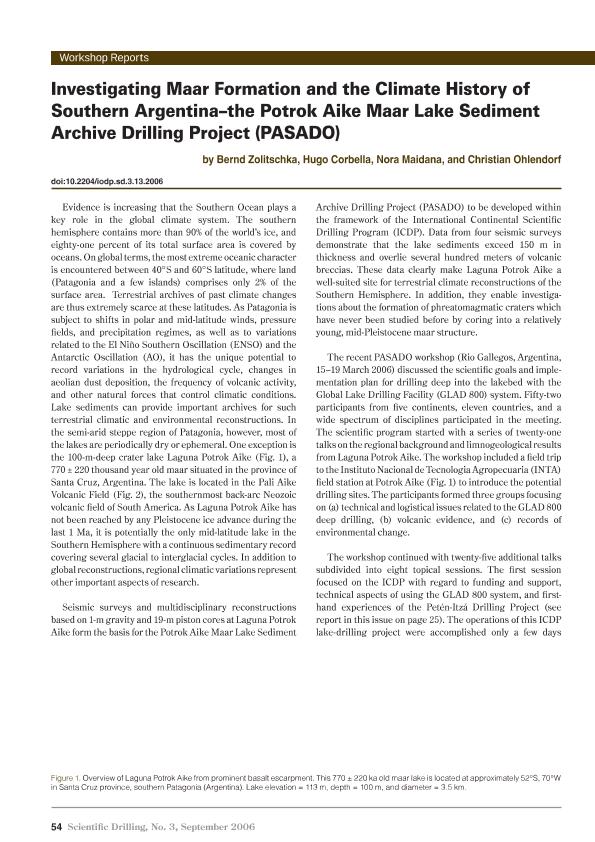Mostrar el registro sencillo del ítem
dc.contributor.author
Zolitschka, Bernd

dc.contributor.author
Corbella, Hugo

dc.contributor.author
Maidana, Nora Irene

dc.contributor.author
Ohlendorf, Christian

dc.date.available
2017-05-18T19:42:46Z
dc.date.issued
2006-09
dc.identifier.citation
Zolitschka, Bernd; Corbella, Hugo; Maidana, Nora Irene; Ohlendorf, Christian; Investigating Maar Formation and the climate history of Southern Argentina–the Potrok Aike Maar Lake Sediment Archive Drilling Project (PASADO); Copernicus Publications; Scientific Drilling; 3; 9-2006; 54-55
dc.identifier.issn
1816-8957
dc.identifier.uri
http://hdl.handle.net/11336/16666
dc.description.abstract
Evidence is increasing that the Southern Ocean plays a key role in the global climate system. The southern hemisphere contains more than 90% of the world’s ice, and eighty-one percent of its total surface area is covered by oceans. On global terms, the most extreme oceanic character is encountered between 40°S and 60°S latitude, where land (Patagonia and a few islands) comprises only 2% of the surface area. Terrestrial archives of past climate changes are thus extremely scarce at these latitudes. As Patagonia is subject to shifts in polar and mid-latitude winds, pressure fi elds, and precipitation regimes, as well as to variations related to the El Niño Southern Oscillation (ENSO) and the Antarctic Oscillation (AO), it has the unique potential to record variations in the hydrological cycle, changes in aeolian dust deposition, the frequency of volcanic activity, and other natural forces that control climatic conditions. Lake sediments can provide important archives for such terrestrial climatic and environmental reconstructions. In the semi-arid steppe region of Patagonia, however, most of the lakes are periodically dry or ephemeral. One exception is the 100-m-deep crater lake Laguna Potrok Aike (Fig. 1), a 770 ± 220 thousand year old maar situated in the province of Santa Cruz, Argentina. The lake is located in the Pali Aike Volcanic Field (Fig. 2), the southernmost back-arc Neozoic volcanic fi eld of South America. As Laguna Potrok Aike has not been reached by any Pleistocene ice advance during the last 1 Ma, it is potentially the only mid-latitude lake in the Southern Hemisphere with a continuous sedimentary record covering several glacial to interglacial cycles. In addition to global reconstructions, regional climatic variations represent other important aspects of research.
dc.format
application/pdf
dc.language.iso
eng
dc.publisher
Copernicus Publications

dc.rights
info:eu-repo/semantics/openAccess
dc.rights.uri
https://creativecommons.org/licenses/by-nc-sa/2.5/ar/
dc.subject
Deep Drilling
dc.subject
Potrok Aike
dc.subject
Climatic Change
dc.subject.classification
Ciencias de las Plantas, Botánica

dc.subject.classification
Ciencias Biológicas

dc.subject.classification
CIENCIAS NATURALES Y EXACTAS

dc.title
Investigating Maar Formation and the climate history of Southern Argentina–the Potrok Aike Maar Lake Sediment Archive Drilling Project (PASADO)
dc.type
info:eu-repo/semantics/article
dc.type
info:ar-repo/semantics/artículo
dc.type
info:eu-repo/semantics/publishedVersion
dc.date.updated
2017-05-17T17:46:56Z
dc.journal.volume
3
dc.journal.pagination
54-55
dc.journal.pais
Alemania

dc.journal.ciudad
Göttingen
dc.description.fil
Fil: Zolitschka, Bernd. Universitat Bremen; Alemania
dc.description.fil
Fil: Corbella, Hugo. Universidad Nacional de la Patagonia Austral; Argentina
dc.description.fil
Fil: Maidana, Nora Irene. Universidad de Buenos Aires. Facultad de Ciencias Exactas y Naturales. Departamento de Biodiversidad y Biología Experimental; Argentina. Consejo Nacional de Investigaciones Científicas y Técnicas; Argentina
dc.description.fil
Fil: Ohlendorf, Christian. Universitat Bremen; Alemania
dc.journal.title
Scientific Drilling
dc.relation.alternativeid
info:eu-repo/semantics/altIdentifier/doi/http://dx.doi.org/10.2204/iodp.sd.3.13.2006
dc.relation.alternativeid
info:eu-repo/semantics/altIdentifier/url/http://www.sci-dril.net/3/54/2006/
Archivos asociados
